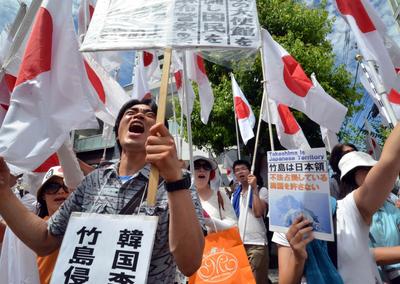Tensions have flared again over the Takeshima/Dokdo islands between Japan and Korea and continue to simmer over the Senkaku/Diaoyu islands with China.

The recent spat with Korea was sparked by Korean President Lee Myung-bak’s bizarre trip to the islands a week or so ago.
In taking the territorial issue right up to Tokyo at the end of his presidency, Lee has taken a leaf out of the book of Russian Prime Minister Dmitry Medvedev, who was the first Russian president to set foot on the Kuril Islands (or the northern territories, as Japan calls these islands in dispute with Russia). Lee’s visit has jeopardised a bilateral summit planned at APEC in Vladivostok and bolstered Japan’s determination to take the dispute to the International Court of Justice.
Japan’s dispute over the Senkakus with China has been simmering below boiling point since the confrontation over a Chinese fishing boat’s ramming a Japanese coast guard vessel in September 2010. Japan’s arrest of the Chinese fishing captain and ramping the incident up to a diplomatic stoush over territory, rather than dealing with it as a low-key fisheries matter, were bad missteps in managing the incident, and they continue to play into Japanese politics and diplomacy in unhelpful ways.
Now firebrand Tokyo Governor, Shintaro Ishihara, has declared his intention to use Tokyo Metropolitan Government funds to purchase three islands of the five-island Senkaku chain from their private landowner to protect them from China, predictably provoking outrage from China and Taiwan. Donors in Japan have contributed over ¥1.3 billion (US$16 million) to a fund for Tokyo to purchase the islands, essentially forcing the central government’s hand and pushing it to assert its authority. Last week, 14 Chinese activists landed on the islands and were arrested by the Japanese authorities. It was the first successful landing in eight years and their arrest represents another Japanese exercise of sovereign administration over the islands. Meanwhile, two Japanese cabinet ministers visited Yasukuni shrine on the anniversary of the end of the war (15 August) throwing fuel on the fire.
Japan has recalled its ambassadors from both Beijing and Seoul over these territorial disputes, albeit for different reasons: from Beijing briefly for consultations on diplomatic niceties and from Seoul until further notice in protest about the Lee visit.
This week’s lead essays, by Kee-seok Kim on the Korea–Japan dispute and by Hitoshi Tanaka on the Japan–China dispute, set the disputes in the context of domestic and regional political affairs. Each offers cautionary advice to their own countrymen.
Kim argues that Lee’s stunt was motivated by an attempt to boost the government’s flagging approval rating. Lee is a lame duck, embroiled in corruption scandals involving his brother. He timed the visit to coincide with the culmination of two weeks of patriotism, after Korean athletes did remarkably well at the London Olympic Games and five days before Liberation Day (at the end of the Pacific War), which celebrates Korea’s emancipation from Japanese colonial rule. The timing was calculated to maximise the popularity of the event, and it seems to have worked. A government poll suggests that, with popular approval of the visit exceeding 80 per cent among Korean people, he may have succeeded. The foreign-policy establishment apparently knew nothing of the visit and are desperately trying to continue business as usual.
The upshot, as Kim points out, is that Lee has given Japan a free kick in putting pressure on Korea. There is no question that, while Japan claims the disputed territory, Korea effectively controls it. This offence against diplomatic decency in the conduct of Korea’s relations with Japan will certainly mean that the next Korean government will face great pressure to yield concessions of one kind or another to restore its bruised relations with Tokyo.
Tanaka warns that the Senkaku/Diaoyu contretemps has broader ramifications for regional relations were it to get out of hand. Beyond the sovereignty of the Senkaku/Diaoyu Islands themselves, politicisation of the issue has potentially involved the US–Japan alliance, Japan–China relations, and China’s overall engagement with the region. ‘The defence of the Senkaku Islands’, he argues, ‘is a critical issue for the US–Japan alliance. Irrespective of historical and legal intricacies, the Senkaku Islands are clearly covered under the US–Japan Security Treaty. After World War II, the US took control of Okinawa, including the Senkaku Islands. The Senkakus were mapped out and included as one of the US administered territories that were returned to Japan as part of the reversion of Okinawa in 1972′. The 2010 Japanese coast guard incident resulted in US declarations that the Senkaku/Diaoyu islands were within the jurisdiction of the US–Japan alliance. Unlike the case of Takeshima/Dokdo, Japan has effective control of the Senkaku Islands. ‘The plan to nationalise the islands — instead of allowing them to be purchased by the Tokyo government — is consistent with Japan’s established policy of maintaining control of the Senkakus in a low-key manner’, Tanaka says.
But, he concludes, the Japanese government has a good way to go to dampen nationalistic antagonism with China by providing a full explanation of its intentions on Senkaku policy, including, presumably, how it welcomes cooperation with China in the management and development of the region.
For Japan, these two disputes, despite their different configurations, are joined at the hip. Both were incorporated into the Japanese empire by cabinet decisions in 1905 and 1895 respectively, and neither was decisively stripped from Japanese sovereignty at the San Francisco treaty conference of 1951, which legalised the post-war territorial settlement in the Far East. And the conflicting claims are not likely to be resolved by legal process any time soon. As Kim and Tanaka suggest, the crucial objective is to preserve a modus operandi that does not disturb the broader peace.
No comments:
Post a Comment